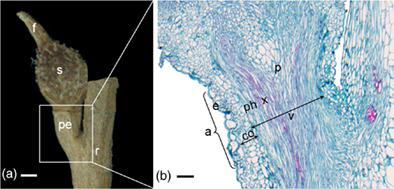当前位置:
X-MOL 学术
›
Plant Species Biol.
›
论文详情
Our official English website, www.x-mol.net, welcomes your
feedback! (Note: you will need to create a separate account there.)
Aerial seed bank in a cold desert annual‐ephemeral species: Role of anatomical structure of stem and delayed fruit dehiscence in timing of seed dispersal
Plant Species Biology ( IF 1.1 ) Pub Date : 2020-05-13 , DOI: 10.1111/1442-1984.12274 Juanjuan Lu 1 , Bing Liu 1 , Dunyan Tan 1 , Carol C. Baskin 1, 2, 3 , Jerry M. Baskin 1, 2
Plant Species Biology ( IF 1.1 ) Pub Date : 2020-05-13 , DOI: 10.1111/1442-1984.12274 Juanjuan Lu 1 , Bing Liu 1 , Dunyan Tan 1 , Carol C. Baskin 1, 2, 3 , Jerry M. Baskin 1, 2
Affiliation

|
Why the fruits are retained on dead upright herbaceous plants and how this relates to seed dispersal and timing of germination remain unclear. Stems of the annual Euclidium syriacum (Brassicaceae) with infructescences bearing indehiscent silicles remain upright after plants die in the spring. We investigated the effect of anatomical structures of stem and pedicle and delayed silicle dehiscence on seed dispersal phenology of this species. For comparison, sections were made of the stem of the annual Goldbachia laevigata (Brassicaceae), which has stems that fall over when plants die. Compared to G. laevigata, the stem of E. syriacum has vascular bundles that are closer together, a thicker xylem and phloem, more fibers, a thicker perimedullary zone and a smaller pith diameter:stem diameter ratio. The thickened pedicle did not form an abcission layer. By late October, 5–20% of seeds were dispersed, depending on the position of infructescences on the plant. Snow covered the plants in late autumn and when it melted in mid‐April many of the plants had fallen over, with a high number of seeds germinating in attached silicles; seedlings became rooted in soil. After snowmelt, 14–15% of the silicles on the remaining upright plants contained seeds; all seeds were dispersed by early July. The anatomical structures of the stem and pedicle plus the delayed dehiscence of silicles explain the presence of an aerial seed bank in E. syriacum and delay of germination of many of seeds until spring. Further, pieces of upright plants are broken off and dispersed by wind, which helps to explain the wide distribution of E. syriacum in the cold desert.
中文翻译:

寒冷的沙漠一年生短暂物种中的空中种子库:茎的解剖结构和延迟的果实开裂在种子传播时机中的作用
为何将这些果实保留在枯死的直立草本植物上以及与种子扩散和发芽时间的关系还不清楚。在春季植物死后,带有不开裂的硅果梗的一年生Euclidium syriacum(十字花科)的茎仍然直立。我们调查了茎和椎弓根的解剖结构以及延迟的硅on裂裂对该物种种子传播物候的影响。为了进行比较,将一年生的Goldbachia laevigata(十字花科)的茎切成部分,该茎在植物死亡时掉落。相比于E. syriacum的茎线虫G. laevigata具有更紧密的血管束,木质部和韧皮部较厚,纤维较多,髓周围区域较厚,髓直径与茎直径之比较小。增厚的椎弓根没有形成脱落层。到十月下旬,种子散布了5–20%,具体取决于植物上的花序位置。到了深秋,雪覆盖了植物,4月中旬融化时,许多植物倒下了,大量种子发芽在附着的硅谷中。幼苗扎根于土壤。融雪后,其余直立植物上的硅柱中有14-15%含有种子。七月初所有种子都散了。茎和椎弓根的解剖结构以及硅棒的延迟开裂解释了在E. syriacum中存在空中种子库并将许多种子的发芽推迟到春季。此外,直立的植物碎片会被风吹散并散开,这有助于解释在寒冷的沙漠中沙丁鱼的广泛分布。
更新日期:2020-05-13
中文翻译:

寒冷的沙漠一年生短暂物种中的空中种子库:茎的解剖结构和延迟的果实开裂在种子传播时机中的作用
为何将这些果实保留在枯死的直立草本植物上以及与种子扩散和发芽时间的关系还不清楚。在春季植物死后,带有不开裂的硅果梗的一年生Euclidium syriacum(十字花科)的茎仍然直立。我们调查了茎和椎弓根的解剖结构以及延迟的硅on裂裂对该物种种子传播物候的影响。为了进行比较,将一年生的Goldbachia laevigata(十字花科)的茎切成部分,该茎在植物死亡时掉落。相比于E. syriacum的茎线虫G. laevigata具有更紧密的血管束,木质部和韧皮部较厚,纤维较多,髓周围区域较厚,髓直径与茎直径之比较小。增厚的椎弓根没有形成脱落层。到十月下旬,种子散布了5–20%,具体取决于植物上的花序位置。到了深秋,雪覆盖了植物,4月中旬融化时,许多植物倒下了,大量种子发芽在附着的硅谷中。幼苗扎根于土壤。融雪后,其余直立植物上的硅柱中有14-15%含有种子。七月初所有种子都散了。茎和椎弓根的解剖结构以及硅棒的延迟开裂解释了在E. syriacum中存在空中种子库并将许多种子的发芽推迟到春季。此外,直立的植物碎片会被风吹散并散开,这有助于解释在寒冷的沙漠中沙丁鱼的广泛分布。











































 京公网安备 11010802027423号
京公网安备 11010802027423号